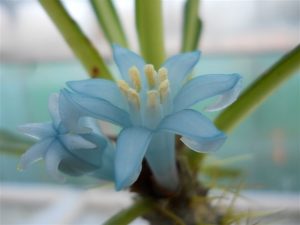Some of us try our best to discourage ants in the garden. I’m not sure why as they really don’t do any harm. However, in the plant kingdom there are a few species that actively encourage ants to live within them in specially created ant homes that are grown by the plant. On the face of it this seems like the oddest thing for a plant to do. On closer examination it becomes clear why a plant would go to the bother of cultivating an ant colony. The most important bonus is a 24/7 security service. Any other animal that might cause harm to the ant plant is instantly attacked by an army of minature defenders with fearsome jaws. Another benefit is that the ant waste contains lots of valuable plant nutrients that are absorbed by special structures inside the home created for the ants.
Right on cue an ant plant from the Arfak Mountains in West Papua, Indonesia, is now flowering as part of a display for Edinburgh International Science Festival. We have enhanced our children’s glasshouse trail – Survival of the Smartest – with a display of plants showing a range of survival adaptations, and among them is Myrmephytum arfakianum with its very odd looking blue flower. To be honest the entire plant is the strangest looking thing. If you image a prickly haggis you just about have it. You can see this botanical curiosity in the Temperate Palm House until Sunday 10th April after which it will be taken off public display.
The ant plant is just one of many plants featuring in the Survival of the Smartest trail for Science Festival. Young explorer’s can discover how plants could help them survive in an emergency and how the plants are able to survive in all sorts of different conditions through smart adaptations. Making homes for ants is really just the begining…
To find out more visit sciencefestival.co.uk


